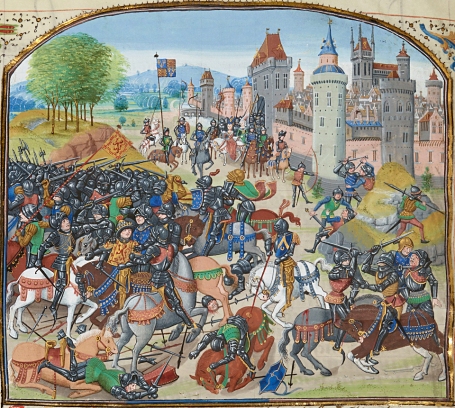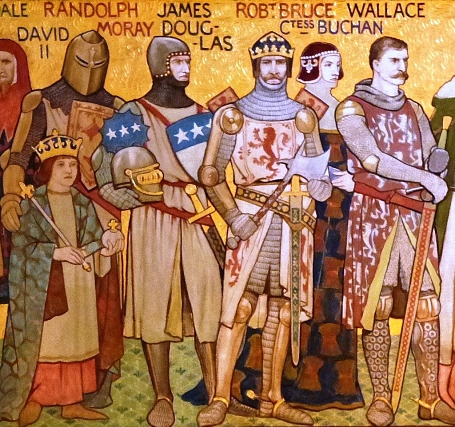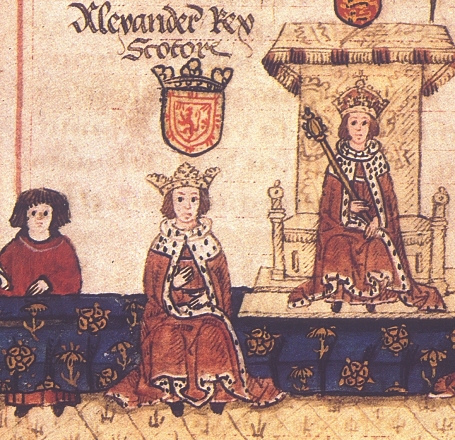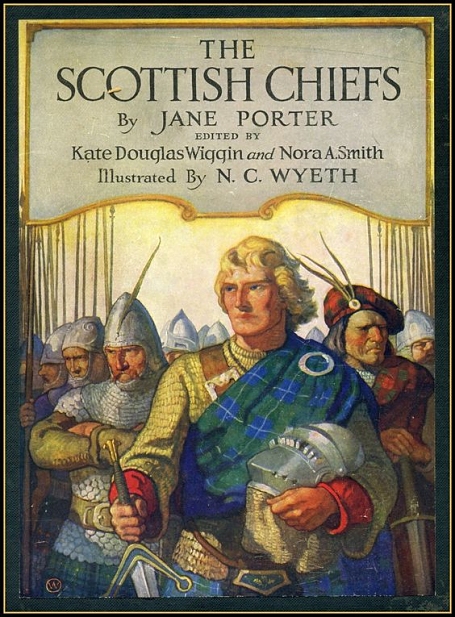The Life and Heroick Actions of the Renoun'd Sir William Wallace,
General and Governour of Scotland
by William Hamilton of Gilbertfield
Synopsis (Continued)
A priest comes in the room and mocks Wallace – "how weak he lies" – and makes reference to the snare Wallace fell into due to his leman. Wallace wakes at the sound of the priest's voice and states that he's not too feeble to continue the fight for Scotland. The priest states the obvious; Wallace's friends are lost and he is without help; he then tells Wallace he should accept Edward as as his "rightful Lord." As Wallace again rebukes the priest, Stephen and Kierly arrive. After a joyful reunion, Wallace leaves with Stephen, Kierly, and the widow's sons.
Wallace now sets about assembling an army. He goes first to Dundaff and meets with an elderly knight, Graham, there. Graham, in a ceremony, swears his and his son's allegiance to Wallace and the fight for Scotland's freedom. The younger Graham departs with Wallace. They then move on to Kilbank, where Wallace is welcomed.
Meanwhile Percy, upon hearing the stories of Wallace's recent conquests, says that if only Wallace would acknowledge Edward as king and accept his peace, Wallace could tame the north of Scotland and inspire the English army.
Wallace sends messages to his friends Boyd and Blair (John Blair, a childhood friend of Wallace's upon whose manuscript, presumably Blind Harry's Wallace is based) and word spreads throughout Scotland that Wallace is gathering supporters and soldiers. All is going well in Wallace's world at the moment; "swarms" of soldiers are gathering, his cares ease, his friends await his orders ... all is going well, until Wallace falls in love.
In Lanark lives a beautiful, pious young lady that Wallace has fallen in love with. No matter how he tries to turn his thoughts away from her and back to war against the English, he fails. He speaks to his friend and compatriot Kierly about the dilemma. Kierly advises Wallace to enjoy her, marry her; she's chaste, virtuous, and of noble Scots blood. They have a philosophical conversation about love, during which a maid arrives from the young lady, whose name is given as Miranda. Miranda has invited Wallace to call on her; Wallace leaves right away, with the maid leading the way.
Wallace and Miranda spend the day talking about the "glorious cause" Wallace has undertaken. As night falls, Wallace leaves and rejoins his friends. Wallace fights down his feelings of love and, with his army, heads toward Lochmabane, which is held by the English, commanded by Clifford. Wallace quickly kills Clifford and heads out of town with his small force; the English send an army to pursue him.
The English archers wound John Blair, enraging Wallace. He turns and faces the enemy. The Scots kill numerous English soldiers, who are led by Moreland. Wallace rides into the midst of the battle and attacks Moreland, and "with a pond'rous Blow, Full on his Neck, divides the Bone in Two." The English soldiers, having lost their commander retreat to the castle in fear of the Scots, where their general, Graystock, derides them with scorn. He assembles a force of fresh soldiers and rides out to do battle with the Scots.
Meanwhile, Wallace and his force, leaving the scene of the battle see Graystock and his army approaching. Wallace's men call out to Graystock that he shouldn't anticipate their loss because they are led by Wallace, "the Valiant God-like Knight, Whose mighty Arm alone lays waste the Fight." Graystock laughs and spurs his horse forward. Wallace is at the rear of his army when his horse gives out. "Dispatch'd by Heaven," Graham appears with thirty men and joins the battle. Wallace fights on foot until the English, again, retreat. The Scots give chase and Graham kills Graystock.
Evening falls; Wallace and his friends are pleased to be reunited and with the outcome of the battle. They sit on a hill overlooking the scene of the battle and discuss what they should do next. The sky is dimly lit by a pale moon as they ride toward the town of Lochmabane. Two spies ride ahead, kill the gatekeeper and admit the rest of the band into the town. Throughout the night they kill the Englishmen residing there, and in the morning take a brief rest, a small meal and quite a bit of wine. They leave the town and, in a protected vale near the River Clyde, go to sleep. Collectively, they dream about Lochmabane Castle, which is still standing and occupied by the English – a dream that wakes them just as night is falling again.
They leave the vale, heading toward the castle, with Wallace going ahead. At the gate he hears laughter and drunken talk. Offended at such merriment during times of war, he gives the sign and his force overtakes the gate, then the town. Wallace heads toward the house where the captain lives and kills him. Meanwhile, Graham and, presumably, his men, are heaping wood around the fort and up to the roofs; Graham throws a flaming brand onto a roof. The fire, fueled by the wind, engulfs the castle enclosure. A turret collapses, crushing those within. By morning the castle is nothing but a smoking heap of rubbish. What walls do still stand, Wallace and his men knock down.
The ballad, The Life and Heroick Actions of the Renoun'd Sir William Wallace, General and Governour of Scotland, by William Hamilton of Gilbertfield, 1722, is in the public domain.

The Kingdom of England and the Kingdom of Scotland fought dozens of battles with each other. They fought typically over land, particularly Berwick-Upon-Tweed, and the Anglo-Scottish border frequently changed as a result. Read more at Wikipedia.

The First War of Scottish Independence was the initial chapter of engagements in a series of warring periods between English and Scottish forces lasting from the invasion by England in 1296 ... Read more at Wikipedia.

Edward I (1239-1307), also known as Edward Longshanks and the Hammer of the Scots, was King of England from 1272 to 1307. Read more at Wikipedia.

Digitized version of The Scottish Chiefs, by Jane Porter, a novelization published in 1921 by Charles Scribner's Sons, about William Wallace and the First Scottish War of Independence. Read online at archive.org.